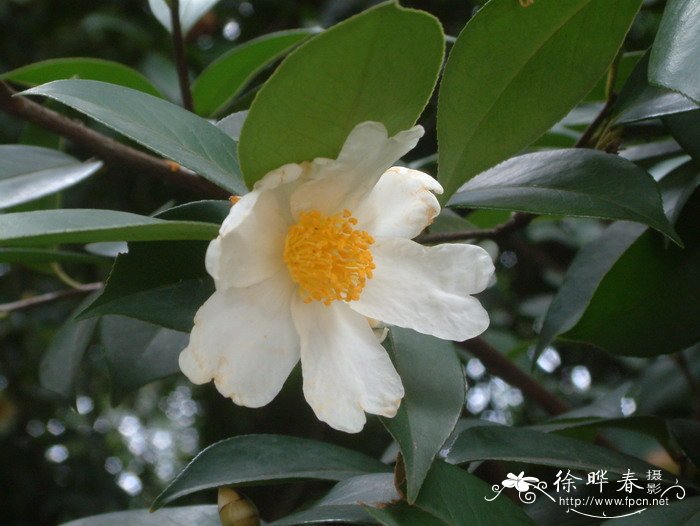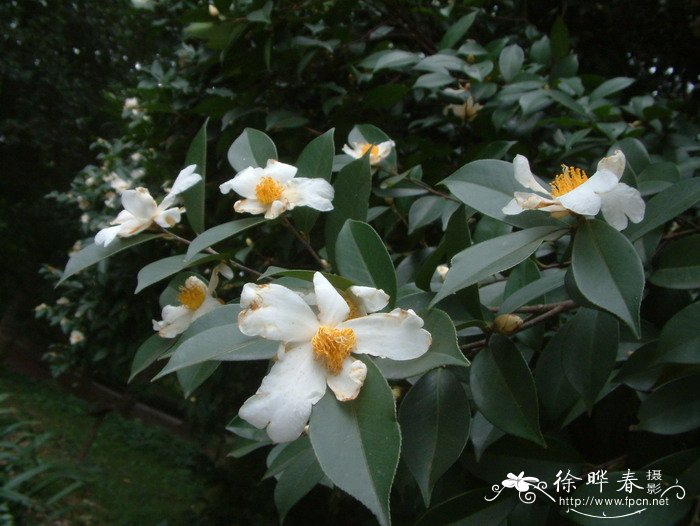越南油茶Camellia drupifera
中文名(Chinese Name):越南油茶
学名(Scientific Name):Camellia drupifera Lour.
英文名(English Common Name):
别名(Chinese Common Name):
异名(Synonym):Camellia gauchowensis H. T. Chang Camellia vietnamensis T. C. Huang ex Hu Drupifera oleosa Rafin.
科属(Family & Genus):山茶科(Theaceae)山茶属
形态特征(Description):灌木至小乔木,高4-8米,嫩枝有灰褐色柔毛,老枝秃净。叶革质,长圆形或椭圆形,有时卵形或倒卵形,长5-12厘米,宽2-5厘米,先端急锐尖,基部楔形或略圆,上面干后发亮,下面有疏毛,侧脉10-11对,在上面陷下,在下面不明显,两面多小瘤状突起,边缘有细锯齿,叶柄长约1厘米,略有短毛。花顶生,近无柄;苞片及萼片9片,阔卵形,由外向内逐渐增大,长6-23毫米,宽4-18毫米,先端凹入,背面无毛,边缘有睫毛;花瓣5-7片,倒卵形,长4.5-6厘米,宽3-4.5厘米,先端2裂;雄蕊排成4-5轮,长12-17毫米,外轮花丝基部1-2毫米相连生,内轮花丝分离,无毛;子房有长绵毛,花柱3-5,离生或先端3-5裂,有微毛。蒴果球形,扁球形或长圆形,长4-5厘米,宽4-6厘米,3-5爿裂开,果爿厚5-9毫米,外面有毛,中轴长3.5厘米;种子6-15粒,长2厘米。
分布(Distribution):产广西,现华南等地作油料植物栽培。
引自中国植物志英文版:FOC Vol. 12 Page 367, 409, 410, 411
Camellia drupifera Loureiro, Fl. Cochinch. 2: 411. 1790.
越南油茶 yue nan you cha | Theaceae | Camellia
Camellia gauchowensis Hung T. Chang; C. vietnamensis T. C. Huang ex Hu; Drupifera oleosa Rafinesque; Thea drupifera (Loureiro) Pierre.
Shrubs or trees, 2-8 m tall, 9-30 cm d.b.h. Young branches grayish brown; current year branchlets reddish brown, glabrous. Petiole 5-7 mm, glabrous; leaf blade elliptic to broadly elliptic, 5-12 × 3-5 cm, leathery, abaxially pale green and glabrous, adaxially dark green, shiny, and hirtellous along midvein or glabrescent, midvein raised on both surfaces, secondary veins 7-9 on each side of midvein, abaxially slightly raised, and adaxially visible, base rounded to obtuse, margin serrulate, apex acute to shortly acuminate and with an obtuse tip. Flowers solitary, axillary, fragrant, 6-7.5 cm in diam., subsessile. Bracteoles and sepals 10-12 or more, caducous, glabrous, margin ciliolate; outer bracteoles and sepals semiorbicular, 1-2 mm; inner bracteoles and sepals sepaloid, ovate to suborbicular, to 1 cm. Petals 5-8, white, nearly distinct, obovate, 3-6 × 1.5-3.5 cm, apically 2-parted for 7-10 mm. Stamens 1.2-1.7 cm, glabrous; outer filament whorl basally connate for 1-2 mm to nearly distinct. Ovary tomentose, 3-5-loculed; styles 3-5, 1-1.5 cm, glabrous, distinct nearly to base. Capsule globose to ovoid, 4-7 cm in diam., 3-5-loculed with 1-4 seeds per locule; pericarp 6-8 mm thick, woody, splitting into 3-5 valves. Seeds brown. Fl. Dec-Jan, fr. Oct. 2n = 30, 105, 120.
Forests, thickets; 100-700 m. SW Guangdong, S Guangxi, Hainan [Vietnam].
This species is grown as a seed oil crop. It is often uncertain if particular collections are wild, cultivated, or escaped. As is the case with several other Camellia species that are cultivated, the original distribution is uncertain.
The identity of Camellia drupifera has long been uncertain. It is an older name than either C. oleifera (1818) or C. kissii (1820) and has been considered to possibly be conspecific with one or the other of these species. Loureiro stated that for C. drupifera the capsule ("Drupa") is 4-loculed and the style 4-parted, which features do not agree with either C. oleifera or C. kissii. All of the characters described by Loureiro as well as its being grown as a seed oil plant are consistent with it being conspecific with C. gauchowensis (probably the wild ancestor with 2n = 30) and C. vietnamensis (cultivated plants with 2n = 105, 120). Although there is no extant type, the Loureiro plant was collected from a cultivated plant in Cochinchina (S Vietnam). To stabilize the nomenclature we are neotypifying the species name here: Camellia drupifera Loureiro, Fl. Cochinch. 2: 411. 1790. TYPE: China. Guangxi: Liucheng Xian, Satang Forest Station in cultivation, Jul 1956, Huang Tso-Chieh [Huang Zuo-Jie] 2042 (neotype designated here, PE) based on the holotype of C. vietnamensis T. C. Huang ex Hu (Acta Phytotax. Sin. 10: 138. 1965).

 (责任编辑:徐晔春)
(责任编辑:徐晔春)
学名(Scientific Name):Camellia drupifera Lour.
英文名(English Common Name):
别名(Chinese Common Name):
异名(Synonym):Camellia gauchowensis H. T. Chang Camellia vietnamensis T. C. Huang ex Hu Drupifera oleosa Rafin.
科属(Family & Genus):山茶科(Theaceae)山茶属
形态特征(Description):灌木至小乔木,高4-8米,嫩枝有灰褐色柔毛,老枝秃净。叶革质,长圆形或椭圆形,有时卵形或倒卵形,长5-12厘米,宽2-5厘米,先端急锐尖,基部楔形或略圆,上面干后发亮,下面有疏毛,侧脉10-11对,在上面陷下,在下面不明显,两面多小瘤状突起,边缘有细锯齿,叶柄长约1厘米,略有短毛。花顶生,近无柄;苞片及萼片9片,阔卵形,由外向内逐渐增大,长6-23毫米,宽4-18毫米,先端凹入,背面无毛,边缘有睫毛;花瓣5-7片,倒卵形,长4.5-6厘米,宽3-4.5厘米,先端2裂;雄蕊排成4-5轮,长12-17毫米,外轮花丝基部1-2毫米相连生,内轮花丝分离,无毛;子房有长绵毛,花柱3-5,离生或先端3-5裂,有微毛。蒴果球形,扁球形或长圆形,长4-5厘米,宽4-6厘米,3-5爿裂开,果爿厚5-9毫米,外面有毛,中轴长3.5厘米;种子6-15粒,长2厘米。
分布(Distribution):产广西,现华南等地作油料植物栽培。
引自中国植物志英文版:FOC Vol. 12 Page 367, 409, 410, 411
Camellia drupifera Loureiro, Fl. Cochinch. 2: 411. 1790.
越南油茶 yue nan you cha | Theaceae | Camellia
Camellia gauchowensis Hung T. Chang; C. vietnamensis T. C. Huang ex Hu; Drupifera oleosa Rafinesque; Thea drupifera (Loureiro) Pierre.
Shrubs or trees, 2-8 m tall, 9-30 cm d.b.h. Young branches grayish brown; current year branchlets reddish brown, glabrous. Petiole 5-7 mm, glabrous; leaf blade elliptic to broadly elliptic, 5-12 × 3-5 cm, leathery, abaxially pale green and glabrous, adaxially dark green, shiny, and hirtellous along midvein or glabrescent, midvein raised on both surfaces, secondary veins 7-9 on each side of midvein, abaxially slightly raised, and adaxially visible, base rounded to obtuse, margin serrulate, apex acute to shortly acuminate and with an obtuse tip. Flowers solitary, axillary, fragrant, 6-7.5 cm in diam., subsessile. Bracteoles and sepals 10-12 or more, caducous, glabrous, margin ciliolate; outer bracteoles and sepals semiorbicular, 1-2 mm; inner bracteoles and sepals sepaloid, ovate to suborbicular, to 1 cm. Petals 5-8, white, nearly distinct, obovate, 3-6 × 1.5-3.5 cm, apically 2-parted for 7-10 mm. Stamens 1.2-1.7 cm, glabrous; outer filament whorl basally connate for 1-2 mm to nearly distinct. Ovary tomentose, 3-5-loculed; styles 3-5, 1-1.5 cm, glabrous, distinct nearly to base. Capsule globose to ovoid, 4-7 cm in diam., 3-5-loculed with 1-4 seeds per locule; pericarp 6-8 mm thick, woody, splitting into 3-5 valves. Seeds brown. Fl. Dec-Jan, fr. Oct. 2n = 30, 105, 120.
Forests, thickets; 100-700 m. SW Guangdong, S Guangxi, Hainan [Vietnam].
This species is grown as a seed oil crop. It is often uncertain if particular collections are wild, cultivated, or escaped. As is the case with several other Camellia species that are cultivated, the original distribution is uncertain.
The identity of Camellia drupifera has long been uncertain. It is an older name than either C. oleifera (1818) or C. kissii (1820) and has been considered to possibly be conspecific with one or the other of these species. Loureiro stated that for C. drupifera the capsule ("Drupa") is 4-loculed and the style 4-parted, which features do not agree with either C. oleifera or C. kissii. All of the characters described by Loureiro as well as its being grown as a seed oil plant are consistent with it being conspecific with C. gauchowensis (probably the wild ancestor with 2n = 30) and C. vietnamensis (cultivated plants with 2n = 105, 120). Although there is no extant type, the Loureiro plant was collected from a cultivated plant in Cochinchina (S Vietnam). To stabilize the nomenclature we are neotypifying the species name here: Camellia drupifera Loureiro, Fl. Cochinch. 2: 411. 1790. TYPE: China. Guangxi: Liucheng Xian, Satang Forest Station in cultivation, Jul 1956, Huang Tso-Chieh [Huang Zuo-Jie] 2042 (neotype designated here, PE) based on the holotype of C. vietnamensis T. C. Huang ex Hu (Acta Phytotax. Sin. 10: 138. 1965).
踩一下[0]

顶一下[1]